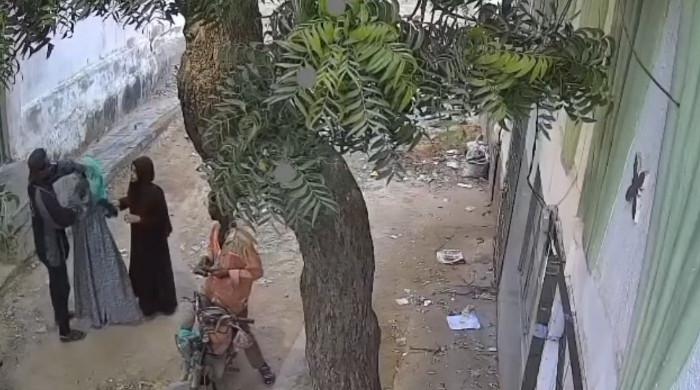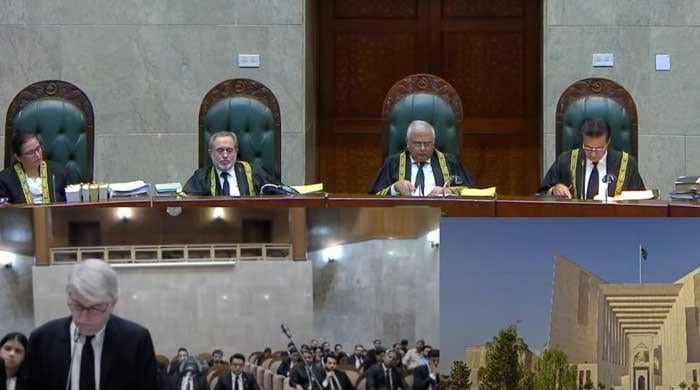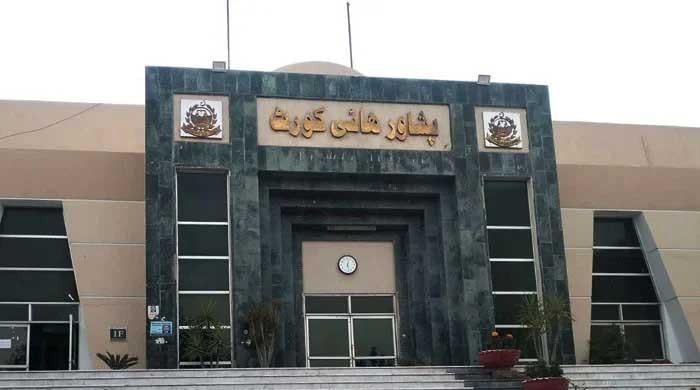Exclusive: ‘Illegal’ electricity bills depriving families nationwide of their hard-earned cash
Geo.tv investigation finds power companies have tampered with electricity tariffs as NEPRA takes a lax approach to enforcing tariff rules
September 08, 2021
- Geo.tv investigation finds households across the country have been overbilled on multiple occasions over the past year.
- Families billed for as many as 37 days in some cases, in complete violation of a 31-day limit under tariffs approved by NEPRA.
- Lawyers say companies setting their own billing periods are tampering with NEPRA’s tariff conditions.
- Simple solution to overbilling issue exists, yet not enforced by NEPRA.
Saifur Rahman in Islamabad and Yaqoob Haroon in Karachi contributed to this report.
A Geo investigation has uncovered that since January this year, a large number of households across the country likely paid higher electricity bills than they should have due to billing malpractices by Pakistani power companies.
While investigating a random sample of electricity bills issued to residential customers this year in eight major cities of the country, Geo.tv found serious irregularities in the way household electricity bills are being calculated by various power companies.
According to the bills reviewed by Geo.tv, Karachi’s K-Electric (KE), the Lahore Electric Supply Company (LESCO), Islamabad Electric Supply Company Limited (IESCO), Faisalabad Electric Supply Company (FESCO), Hyderabad Electric Supply Company (HESCO), Multan Electric Power Company (MEPCO), Gujranwala Electric Power Company (GEPCO) and the Sukkur Electric Power Company (SEPCO) each billed their customers for more than 31 days in a single month on more than one occasion since January 2021.
This is a serious breach of an important condition regarding the maximum length of a billing month set by the country’s apex power sector regulator — the National Electric Power Regulatory Authority (NEPRA).
Read more: K Electric ‘illegally’ overbilled Karachiites in July, netting crores in excess revenue
In its standard Terms and Conditions of Tariff, NEPRA rules that: “‘Month’ or ‘Billing Period’, unless otherwise defined for any particular tariff category, means a billing month of 30 days or less reckoned from the date of the last metre reading.”
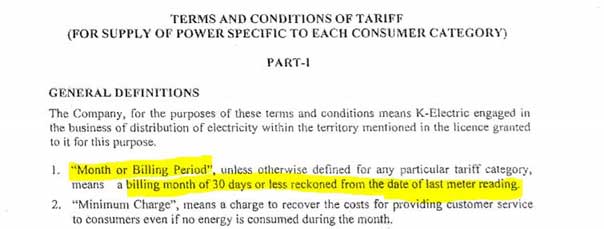
On Sep 6, in response to questions sent by Geo.tv, NEPRA elaborated this rule in the following words:
“From the above definition it is clear that […] 30 days are in addition to the day on which last metre reading was carried out, thus making it 31 days where applicable. Therefore, the definition accounts for those months having 31 days and also for those months having less than 31 days.”
This 31-day rule is a critical component in the government’s calculation of how much electricity subsidy each residential customer is entitled to in a month. It is also crucial in determining when to apply the new 7.5% income tax penalty that has been imposed since July on customers whose electricity bills exceed Rs25,000.
Yet, either due to gross negligence or disregard for the law, power companies have been tampering with the tariff conditions by billing customers for as much as 37 days, forcing them to pay higher electricity charges and taxes than they are legally liable to pay.
Read more: For households on slab-based tariffs, even a single day billed extra can mean big penalties
How does this affect me?
Your household electricity bill is calculated under one of two applicable tariffs.
You may either be charged under a ‘single phase’ tariff (also described as a slab-based tariff), or you may be billed under a ‘three phase’ tariff (also described as the Time of Use – ToU – tariff).
Consumers on slab-based tariff are charged varying rates on the basis of the total number of units of electricity they have consumed in a month, regardless of what time of day the units were consumed. Most residential consumers fall in this category, as the slab-based tariff applies to small houses and apartments with lower than 5kW of sanctioned load.
Meanwhile, ToU consumers are charged for their monthly electricity usage under two flat rates: their electricity consumption in peak hours and their electricity consumption in off-peak hours. Most large residences, with a sanctioned load of 5kW and above, fall in this category.
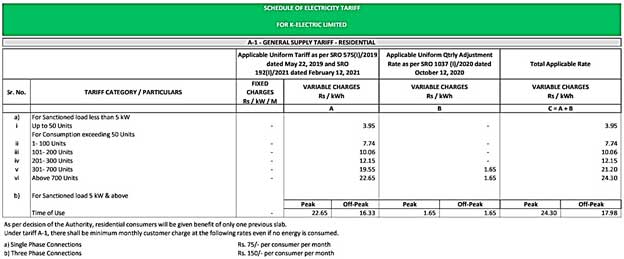
Setting NEPRA's rule to the side, some power sector officials argue that tinkering with the length of the billing period does not really have any serious consequences, as it does not matter if you are billed for the units you consume in this month or the next.
The argument is that if you are billed for 35 days in month, what does it matter if you pay for all 35 days of electricity usage this month, or the additional 4 days' usage in the next?
Contrary to what these officials argue, however, exactly how much electricity you get charged in one bill does matter, and both categories of customers (slab-based and ToU) risk being exposed to unfair financial burdens if they are charged for more than 31 days by power companies.
For ToU customers, the additional burden is mainly limited to the risk of being slapped with a 7.5% income tax charge if the extra days they are being billed for push their bill to Rs25,000 or beyond.
This is a new penalty imposed by the government starting July 2021, and is supposed to penalise tax non-filers only. However, given that countless people use electricity on connections that are registered in someone else’s name (landlords, past owners, etc.), they remain vulnerable to this charge even if they themselves file taxes.
On the other hand, single-phase tariff customers face two different risks according to their level of consumption. On one hand, those with higher monthly consumption of electricity (roughly more than 1,000 units) face the same risk as ToU customers (i.e., unfair imposition of income tax), while on the other, those who consume below 700 units of electricity (including some of the most vulnerable customers) face the risk of being robbed of the subsidies that have been allocated for them by the Government of Pakistan.
How are households robbed of their electricity subsidy if they are billed for more than 31 days? Click here for a detailed analysis.
What have power companies been up to?
An investigation using a random sample of bills sent out by IESCO, LESCO, MEPCO, FESCO, GEPCO, SEPCO, HESCO, and KE revealed that all seven companies are guilty of charging customers for more than 31 days of electricity usage in a single monthly bill.
In other words, each of these companies violated NEPRA's billing period rule on at least one occasion since January this year, and the majority were repeat offenders.
MEPCO, which supplies electricity to Multan, came across as the company that most blatantly abused the rule: in May, for example, it charged customers for 36 and 37 days of electricity use on the excuse of Eid ul Fitr holidays.
The second major violator, SEPCO, which supplies to Sukkur, billed customers for 35 days in May (presumably on account of Eid ul Fitr) and 34 days in July (on account of Eid ul Azha).
HESCO, GEPCO and FESCO, which supply to Hyderabad, Gujranwala and Faisalabad, each were found to have issued bills for 33 days of electricity use, with GEPCO and FESCO also sending 33-day bills and HESCO sending 32-day bills on more than one occasion in the past 8 months. FESCO also charged customers for 34 days in the month of May, likely on the pretext of Eid ul Fitr holidays.
Likewise, KE, which supplies electricity to Karachi and its adjoining areas, was found to have issued 33 and 32-day bills in the past 8 months on more than one occasion. LESCO (Lahore) too sent out 33 day bills to at least some customers in the month of August.
IESCO, which supplies electricity to Islamabad, Rawalpindi, Chakwal, Jhelum and Attock cities, also billed its customer for 33 days at least once this year.
Update: An earlier version of this story had stated that IESCO did not overbill its consumers, however, the latest information made available to this scribe suggests otherwise.
These companies repeatedly overstepped their bounds despite NEPRA allowing no relaxation or exception to the 31-day rule.
“In case any [power distribution company] has billed any consumer, over and above [the maximum 31 day limit], specific cases if any, may be referred to the Authority as consumer complaint so that the Authority can take action against the said utility,” NEPRA said in a statement to Geo.tv.
What do the companies say?
When we questioned power sector officials on the legality of issuing bills of more than 31-days, their initial response was that there was nothing wrong with the practice because companies are sometimes forced to extend billing periods for a day or two due to various operational reasons.
It also appears that some companies were operating under the added assumption that they could extend metre readings well beyond 31 days too if the reading date fell on a Sunday or a public holiday (leading to billing periods as long as 37 days in the case of MEPCO).
While some of the points raised by power companies are legitimate — i.e., companies do face significant operational challenges in ensuring that meter readings for millions of customers are taken promptly — altering the billing period and thereby burdening customers isn't exactly a 'legal' solution to their problems.
Legal views on ‘excessive’ billing
With its formal clarification on the maximum length of a billing period, issued on Sep 6 in response to Geo.tv’s questions, NEPRA has made it clear that not a single day billed beyond 31 days is acceptable to the regulator, and that such violations are liable for regulatory action.
For guidance on this matter, this correspondent also spoke to lawyers who specialise in contract law and dispute resolution. They pointed out a number of issues with the power companies’ core argument.
“NEPRA is the sole authority with the power to notify [electricity] tariffs,” Maria Farooq, partner at Axis Law and an expert on power sector dispute resolution, explained to this correspondent.
“Now, whenever NEPRA approves a tariff for a company, it does so with certain rules and conditions.
“If it [NEPRA] specifies a condition that a billing period for an approved tariff has to be a maximum 31 days and does not provide any exception or relaxation to this condition in the tariff issued to the company in question, the company is legally bound by this condition.”
“There is no question that the company can then interpret the condition imposed on it to mean anything contradictory. That is not how such conditions in tariffs work.”
To illustrate, Farooq, who is also a seasoned international commercial arbitration lawyer, explained that lawyers take care to include phrases like “working days” when they want to make clear distinctions when referring to time periods.
“They [NEPRA] could have said that billing must be concluded in 25 working days from the date of the last metre reading, in which case it would have been acceptable for the metre reading to be delayed to a working day in case the deadline fell on a weekly or public holiday,” she explained.
“In this case, there is no such language used, which means it is reasonable to interpret the maximum length of the billing period as simply 31 calendar days – [which is] 31 days, public holidays and weekly offs included,” she explained.
“In the absence of any exception/relaxation given by NEPRA, [a DISCO] cannot unilaterally say that it can interpret the billing period to mean something other than what NEPRA has defined it as. That is akin to changing the terms of the tariff, and the company does not have any authority to do such a thing. The tariff can only be changed by NEPRA, and it only does so through a legal process after which it notifies it to the public,” she concluded.
The absence of any relaxation as regards the 31-day billing period in NEPRA’s tariff was also pointed out to this correspondent by a senior associate at an international law firm which advises multinationals on various aspects of corporate law. They asked to remain anonymous due to their firm’s policies regarding interactions with the media.
“If the scheduled metre reading for a customer was to fall on the first day of Eid, will [electric companies] wait for the fourth day of Eid to conduct a metre reading?” they had asked, questioning how such a thing can be argued to be permissible given the significant extra burden it could put on customers.
“Because it [the agreement] says 31 days or less, [the company] needs to figure out when to read metres, considering weekends and public holidays, so that they remain within [the] 31 days [deadline],” they added.
“It can’t be more than 31 days.”
Is there any solution to the overbilling issue?
However, despite it now being established that there are systemic issues in how the majority of power companies are conducting their billing, NEPRA's response suggests it will be taking reactive rather than proactive measures.
The regulator’s statement to Geo.tv suggested that no broad inquiry or audit will be initiated to determine the scale of violation of tariff rules by power companies and its potential impact on end users. Rather, NEPRA indicated that it will only take action if and when specific cases are registered by affected citizens through its consumer complaints cell.
This is problematic because not all families may be able to make the complex calculations regarding how their tariff slabs or tax liabilities may have been impacted by their power company’s decision to bill them for more than 31 days. Therefore, these families are likely to never approach NEPRA or receive any restitution for unfair charges they may have paid.
This is great for the power companies in question, as it allows them to deal with the odd complainant while mostly keeping their books shut and avoiding expensive audits to reckon with the scale of the legal mess they have created.
In fact, despite being presented with mathematical and logical reasoning to demonstrate how extending the billing period can have irreversible adverse financial consequences for end users, it seems power sector officials remain unable to grasp the core of the problem.
They continue to argue that some customers may be overbilled one month, but will then be 'underbilled' the next month when the excess days charged in the first month are 'adjusted' in the second. There are two things fundamentally wrong with this argument: as we have demonstrated, charging for less days does not always reverse the impact of if you are charged for more days in a month and get pushed into a higher slab because of that. Secondly, charging for less days is actually legal, while charging for more than the maximum allowed days is not.
Further, NEPRA will continue to face the fundamental question of how companies the can be provided reasonable operational flexibility when collecting metre readings, while also safeguarding the right of the people to receive the subsidies that have been allocated for them.
However, a simple solution exists that can forever lay to rest this issue.
A no-cost, no hassle solution
At least some of Pakistan’s regional neighbours already use a simple mathematical formula to protect the interests of both their consumers and power generation industry in case changes have to be made by companies to their billing period.
In both India and Malaysia, where domestic customers are charged under similar slab-based tariffs as in Pakistan, billing rules mandate that a ‘proration factor’ be applied to modify the tariff slabs proportional to the number of days the customer is being billed for.
The ‘proration factor’ is a ratio, and the idea behind it is based on elementary math. What it does is it expands or narrows the standard slabs of the tariff based on the actual number of days billed so that consumers continue to receive the benefits allowed under the original tariff.
Here’s how it works: for example, if a tariff has been approved for a maximum 31-day period and a customer has been billed for 32 days, the proration factor is calculated by dividing the total days billed by the maximum days billable under the tariff (in this case, 32 days/31 days).
In this case, the ‘proration factor’ turns out to be: 32/31 = 1.032
We now use this multiple to expand the slabs in order to preserve the slab benefit for those deserving of the subsidy. This is done by multiplying the upper limit of each slab by the proration factor and substituting the lower limits accordingly (all numbers are rounded off to the nearest integer).
| Original Slabs | Proration Calculation | Prorated Slabs for 32-day billing | Tariff (unchanged) |
| Slab 1: 1-100 units | (Slab 1 lower limit)*(1.03) | (Slab 1 upper limit)*(1.03) | Slab: 1 1-103 units | Rs7.74/unit |
| Slab 2: 101-200 units | (New Slab 1 upper limit +1) | (Slab 2 upper limit)*(1.03) | Slab 2: 104-206 units | Rs10.06/unit |
| Slab 3: 201-300 units | (New Slab 2 upper limit +1) | (Slab 3 upper limit)*(1.03) | Slab 3: 207-309 units | Rs12.15/unit |
| Slab 4: 301-700 units | (New Slab 3 upper limit +1) | (Slab 4 upper limit)*(1.03) | Slab 4: 310-721 units | Rs19.55/unit |
| Slab 5: 701 units and above | New Slab 4 upper limit +1 | Slab 5: 722 units and above | Rs22.65/unit |
From the table, if a customer uses 100 units in 31 days, they will fall in Slab 1. However, if they are going to be billed for 32 days instead of 31, they should continue to be charged the Slab 1 tariff till up to 103 units in the 32-day period instead of just 100.
The proration factor therefor modifies the original slabs to fairly reflect what they should be for a 32-day period instead of a 31-day period, without changing the underlying tariff structure.
The beauty of the mechanism is that the underlying tariff, despite the billing period now being 32 days, is the same — only the slabs have been proportionately adjusted to give customers the same slab benefits they would have gotten under 31 days of billing.
It doesn't require NEPRA to go into a lengthy tariff review process, or face customer complaints each time a company makes a change to its billing cycle; and it doesn't require companies to perpetually stress about operational challenges that may prevent on-time meter readings for all customers.
The same formula can also be applied to adjust the slabs for as many extra days customers have been billed for. This preserves customers' due subsidies while also giving companies some flexibility to change meter reading dates in case operational issues prevent timely reading.
| Original Slabs (31 days) | Slabs for 32 days | Slabs for 33 days | Slabs for 34 days | Slabs for 35 days | Tariff (unchanged) |
| Slab 1: 1-100 units | Slab 1: 1-103 units | Slab 1: 1-106 units | Slab 1: 1-110 units | Slab 1: 1-113 units | Rs7.74/unit |
| Slab 2: 101-200 units | Slab 2: 104-206 units | Slab 2: 107-213 units | Slab 2: 111-219 units | Slab 2: 114-226 units | Rs10.06/unit |
| Slab 3: 201-300 units | Slab 3: 207-309 units | Slab 3: 214-319 units | Slab 3: 220-329 units | Slab 3: 227-339 units | Rs12.15/unit |
| Slab 4; 301-700 units | Slab 4: 310-721 units | Slab 4: 320-745 units | Slab 4: 330-768 units | Slab 4: 340-790 units | Rs19.55/unit |
| Slab 5: 701 units and above | Slab 5: 722 units and above | Slab 5: 746 units and above | Slab 5: 769 units and above | Slab 5: 791 units and above | Rs22.65/unit |
The same proration factor can also be multiplied by the limit set by the government on which income tax becomes applicable on electricity consumers. This means that if a customer has to pay 7.5% income tax on 31 days of usage amounting to Rs25,000, they will be only be required to pay the income tax if their usage touches or crosses Rs25,806 over 32 days.
| Billing period | 31 days | 32 days | 33 days | 34 days | 35 days |
| Income tax applicable on: | Rs25,000 and above | 25,806 and above | Rs26,613 and above | Rs27,419 and above | Rs28,226 and above |
Proration also protects the billing company and the government’s interests if, for some reason, there is a need to shorten the billing period. For example, the limit at which income tax becomes applicable falls to Rs22,580 if billing is being conducted over a 28-day period instead of 31 days.
The proration factor can be applied to the case study discussed in our initial story, where a customer was shown to have been disproportionately overcharged when they were billed for 701 units over a 32-day period.
In terms of the cost impact to the customer, the relevant electricity charges for 701 units (without taking into account quarterly adjustments, other charges and taxes) under the original slabs were calculated to be:
Slab 4 700 units @ 19.55 rupees per unit; and the remaining
Slab 5 1 unit @ 22.65 per unit
Which amounted to (700*19.55) + (1*22.65) = Rs13,707.65
Now, if the same customer had been charged for 701 units but according to the prorated slabs illustrated in the table above, they would have been charged:
Slab 3 309 units @ 12.15 rupees per unit; and the remaining
Slab 4 392 units @ 19.55 rupees (+quarterly adjustment charges) per unit
Which would come out to be: (309*12.15) + (392*19.55) = Rs11,418
This would still be higher than what a 31-day bill would have been, but still fair. In this case, it could rightfully be argued that the customer had not been overcharged as they had been given the same benefits of ‘normal’ tariff slabs in proportion to the two extra days they were charged for.
A simple, yet elegant solution to a problem that both NEPRA and the power companies seem to be struggling to wrap their hands around.
An earlier version of this story had stated that IESCO did not overbill customers in the period reviewed. However, new information received after the story's publishing suggests that the utility sent out 33-day bills to residents in Chakwal.




